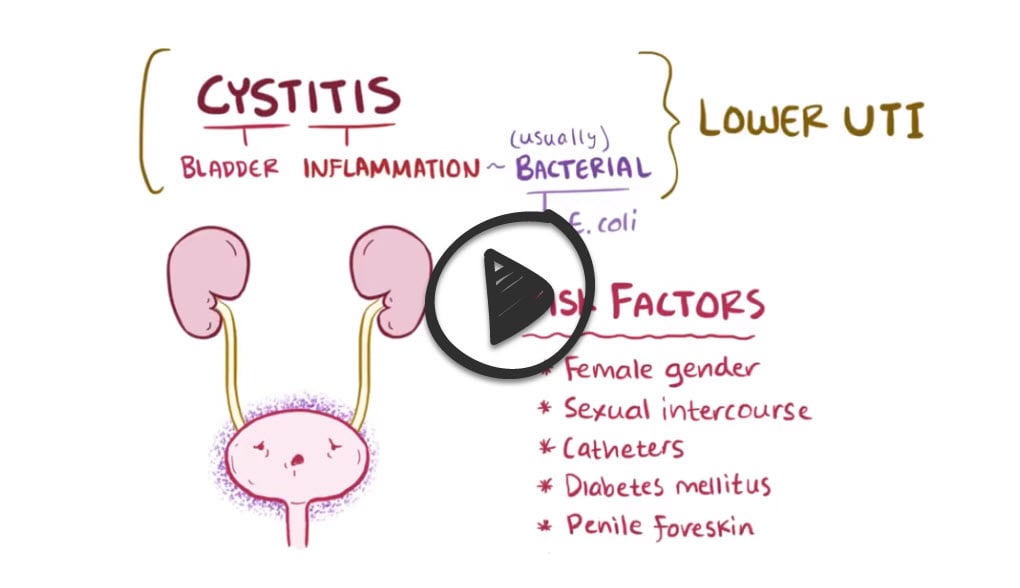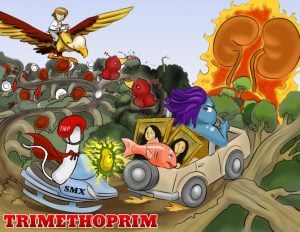Patient will present as → a 34-year-old woman with a 3-day history of hematuria, dysuria, increased urinary frequency, and nocturia. She has had no fever, chills, or back pain. On examination, she does not look ill. Her temperature is 37.5 ° C. Her abdomen is nontender. There is no CVA tenderness.

To watch this and all of Joe Gilboy PA-C's video lessons you must be a member. Members can log in here or join now.
Cystitis is an infection of the bladder
- Characterized by dysuria (painful urination) WITHOUT urethral discharge
- frequent urination/urgency, +/- hematuria
- Abdominal or suprapubic pain
- New-onset incontinence (in toilet-trained children)
- Absence of fever, chills, or flank pain
- The most common cause is E. coli (80%) - gram-negative - Klebsiella; Proteus; Enterobacter; Citrobacter
- Gram-positive bacteria: Enterococcus; S. saprophyticus, second most common, esp. in young individuals who are biologically female, sexually active
- Common in women, in whom cases of uncomplicated cystitis are often preceded by sexual intercourse (honeymoon cystitis)
- In men, a bacterial infection of the bladder is usually complicated and usually results from ascending infection from the urethra or prostate or is secondary to urethral instrumentation
- The most common cause of recurrent cystitis in men is chronic bacterial prostatitis
Urine dipstick ⇒ nitrite, leukocyte esterase (enzyme created by white blood cells)
- Urinalysis: pyuria (white blood cells in urine), bacteriuria, +/− hematuria, +/− nitrites
- Urine culture (gold standard)
- > 100,000 CFU/mL (women)
- > 1000 CFU/mL men or cath patients
- → takes 24 h to obtain results
- Imaging studies are not required for most women with UTIs and are warranted only if pyelonephritis, recurrent infections, or concern for anatomic abnormalities
Uncomplicated UTI (adolescents and adults who are nonpregnant, non-diabetic, afebrile, immunocompetent, and without genitourinary anatomic abnormalities)
- Trimethoprim-sulfamethoxazole (TMP-SMZ; Bactrim): 160/800 mg PO BID × 3 days, best where the resistance of E. coli strains <20%
- A 5-day course of nitrofurantoin or a 3-day fluoroquinolone course should be used in patients with allergy to TMP-SMZ and in areas where E. coli resistance to TMP-SMZ >20%.
- Fosfomycin (Monurol): 3 g PO single dose (expensive)
The urinary tract topical analgesic phenazopyridine (Pyridium) 100–200 mg TID produces rapid relief of symptoms and should be offered to patients with more than minor discomfort; it is available over the counter. This medication is not a substitute for definitive treatment. This medication also may alter urinalysis but not the urine culture.
Treatment of uncomplicated UTIs reduces morbidity, but the risk of recurrence stays the same
- All pregnant women with bacteriuria should be treated
- Asymptomatic bacteriuria is commonly seen in the geriatric population and no treatment is needed as long as the patient is not diabetic or has no structural abnormalities of the genitourinary tract.
Treatment update
"You'll see more emphasis on limiting the use of quinolones. It's coming from more concerns about "collateral damage" leading to resistance...and warnings of tendon rupture, peripheral neuropathy, etc. Watch for situations where you may want to bench quinolones. Urinary tract infections. Use nitrofurantoin or trimethoprim/sulfamethoxazole (TMP/SMX) for most UNcomplicated UTIs. Nitrofurantoin used to be discouraged in renal insufficiency...but the new thinking is that it's safe and effective if CrCl > 30 mL/min. Also consider a cephalosporin (cephalexin, etc) or Monurol(fosfomycin)...depending on the bug causing the UTI. Save quinolones (ciprofloxacin, etc) for COMPLICATED UTIs when appropriate...such as patients with obstruction (kidney stones, etc) - Prescriber's Letter "
Lower UTI in pregnancy
- Cefpodoxime, amoxicillin-clavulanate, and fosfomycin are appropriate agents given their safety in pregnancy and the somewhat broader spectrum of activity compared with other agents (such as amoxicillin or cephalexin)
- Fluoroquinolones are NOT safe during pregnancy and are usually avoided in the treatment of children.
- TMP-SMX use in pregnancy is NOT desirable (especially in 3rd trimester) but is appropriate in some circumstances
Postcoital UTI: low-dose nitrofurantoin (50 to 100 mg orally postcoitally or at bedtime) or cephalexin (250 to 500 mg orally postcoitally or at bedtime) may reduce the frequency of UTI in sexually active women
Complicated UTI (diabetes, febrile, immunocompromised patient, recurrent UTIs): Extend course to 7–10 days of treatment with antibiotic chosen based on culture results; may begin with fluoroquinolone, TMP-SMX, or cephalosporin while awaiting results (avoid using nitrofurantoin for complicated UTI)
- Cephalosporin x 14 days are the first-line oral agent in the treatment of UTI in children without genitourinary abnormalities
- First-generation cephalosporin (Keflex 50-100 mg/kg BID) for low risk of renal involvement
- Second-generation (cefuroxime) or third-gen (cefixime, cefdinir, ceftibuten) for those with a high likelihood of renal involvement
 Osmosis Osmosis |
|
 |
 Fluoroquinolones are a family of broad spectrum antibiotic drugs that commonly end with suffix floxacin like ciprofloxacin and moxifloxacin. These drugs are bactericidal and eradicate bacteria by interfering with DNA replication. Fluoroquinolones inhibit topoisomerase II enzymes including bacterial DNA gyrase. These enzymes cut both strands of the DNA helix in order to unwind DNA tangles and supercoils which is necessary for proper DNA replication. These drugs are broad spectrum antibiotics that play an important role in the treatment of serious bacterial infections, especially against gram negative rod infections. Fluoroquinolones, especially ciprofloxacin, is commonly used in the treatment of urinary tract infections and also used in the treatment of Pseudomonas and Neisseria infections. Products containing multivalent cations, like aluminum or magnesium containing antacids, result in drastic reduction of oral absorption and should not be taken together. In general, adverse effects to fluoroquinolones are generally mild to moderate and include diarrhea, skin rashes, and headaches. On occasion, more serious adverse effects can occur. Fluoroquinolones can damage cartilage and ligaments and can cause spontaneous tendon rupture. They are also associated with fibromyalgia like symptoms including leg cramps and myalgias in children. Because they can damage cartilage and ligaments, they are not recommended for use in pregnant women or children and are considered a teratogen.
Fluoroquinolones are a family of broad spectrum antibiotic drugs that commonly end with suffix floxacin like ciprofloxacin and moxifloxacin. These drugs are bactericidal and eradicate bacteria by interfering with DNA replication. Fluoroquinolones inhibit topoisomerase II enzymes including bacterial DNA gyrase. These enzymes cut both strands of the DNA helix in order to unwind DNA tangles and supercoils which is necessary for proper DNA replication. These drugs are broad spectrum antibiotics that play an important role in the treatment of serious bacterial infections, especially against gram negative rod infections. Fluoroquinolones, especially ciprofloxacin, is commonly used in the treatment of urinary tract infections and also used in the treatment of Pseudomonas and Neisseria infections. Products containing multivalent cations, like aluminum or magnesium containing antacids, result in drastic reduction of oral absorption and should not be taken together. In general, adverse effects to fluoroquinolones are generally mild to moderate and include diarrhea, skin rashes, and headaches. On occasion, more serious adverse effects can occur. Fluoroquinolones can damage cartilage and ligaments and can cause spontaneous tendon rupture. They are also associated with fibromyalgia like symptoms including leg cramps and myalgias in children. Because they can damage cartilage and ligaments, they are not recommended for use in pregnant women or children and are considered a teratogen.
| Fluoroquinolones Antibiotics | Play Video + Quiz |
| Fluoroquinolones Toxicities | Play Video + Quiz |
Trimethoprim
Trimethoprim is a bacteriostatic antibiotic that inhibits bacterial dihydrofolate reductase. This enzyme normally reduces dihydrofolic acid to tetrahydrofolic acid using NADPH as an electron donor. Inhibition of this enzyme leads to inhibition of the synthesis of tetrahydrofolic acid, which is essential in the synthesis of nucleotides for DNA synthesis. Trimethoprim is commonly used in combination with sulfamethoxazole, which is a sulfonamide antibiotic that is a competitive antagonist of PABA metabolite and causes inhibition of the enzyme dihydropteroate synthetase, also in the folic acid synthesis pathway. Using these drugs in combination causes sequential block of folate synthesis and has a synergistic effect. Trimethoprim is commonly used in the treatment of recurrent urinary tract infections and is also effective against Shigella and Salmonella. Specifically, TMP-SMX is used for both prophylaxis and treatment of Pneumocystis jiroveci. The use of this antibiotic can cause a decrease in red and white blood cell counts due to lowering of folic acid levels in the individual. This side effect can be alleviated with the administration of leucovorin, also called folinic acid. Leucovorin is a derivative of tetrahydrofolic acid that has activity equivalent to that of folic acid. Leucovorin does not require dihydrofolate reductase for activation and is therefore not inhibited by drugs like trimethoprim.
Play Video + QuizSulfonamides
 Sulfonamides are a group of bacteriostatic antibiotics that contain a sulfonamide moiety. These drugs have a wide spectrum encompassing most Gram positive and many Gram negative organisms including nocardia and Chlamydia. Sulfonamides are structural analogs and competitive antagonists of para-aminobenzoic acid (PABA) and compete with para-aminobenzoic acid (PABA) for incorporation into folic acid. Incorporation of sulfonamides causes inhibition of the enzyme dihydropteroate synthetase in the folic acid synthesis pathway. Because folic acid is necessary for vital cell functions like DNA synthesis, bacteria that are deprived of folate will eventually die. Commonly used sulfonamides include sulfamethoxazole, sulfisoxazole, and sulfadiazine. The overall incidence of adverse drug reactions is approximately 3% and common symptoms include skin reactions ranging from mild rashes to life-threatening Stevens Johnson syndrome, liver and kidney injury, lung reactions and blood reactions. Common sulfa drugs include sulfasalazine, sulfonylureas, thiazide diuretics, acetazolamide, furosemide, celecoxib, and probenecid. Sulfonamides are also associated with causes hemolysis of red blood cells in G6PD deficiency individuals. Additionally, they can cause nephrotoxicity, and photosensitivity. In the plasma, sulfonamides can bind to albumin and displace bilirubin to cause kernicterus in infants and can also displace warfarin, causing unexpected increases in clotting time and uncontrolled bleeding in individuals on warfarin therapy.
Sulfonamides are a group of bacteriostatic antibiotics that contain a sulfonamide moiety. These drugs have a wide spectrum encompassing most Gram positive and many Gram negative organisms including nocardia and Chlamydia. Sulfonamides are structural analogs and competitive antagonists of para-aminobenzoic acid (PABA) and compete with para-aminobenzoic acid (PABA) for incorporation into folic acid. Incorporation of sulfonamides causes inhibition of the enzyme dihydropteroate synthetase in the folic acid synthesis pathway. Because folic acid is necessary for vital cell functions like DNA synthesis, bacteria that are deprived of folate will eventually die. Commonly used sulfonamides include sulfamethoxazole, sulfisoxazole, and sulfadiazine. The overall incidence of adverse drug reactions is approximately 3% and common symptoms include skin reactions ranging from mild rashes to life-threatening Stevens Johnson syndrome, liver and kidney injury, lung reactions and blood reactions. Common sulfa drugs include sulfasalazine, sulfonylureas, thiazide diuretics, acetazolamide, furosemide, celecoxib, and probenecid. Sulfonamides are also associated with causes hemolysis of red blood cells in G6PD deficiency individuals. Additionally, they can cause nephrotoxicity, and photosensitivity. In the plasma, sulfonamides can bind to albumin and displace bilirubin to cause kernicterus in infants and can also displace warfarin, causing unexpected increases in clotting time and uncontrolled bleeding in individuals on warfarin therapy.
| Sulfonamides Mechanisms | Play Video + Quiz |
| Sulfonamides Side Effects | Play Video + Quiz |
| Sulfa Drug Allergies | Play Video + Quiz |
Question 1 |
Fever and chills Hint: Signs of systemic toxicity, such as fever and chills, are absent in acute cystitis. | |
CVA tenderness Hint: CVA tenderness and flank pain are associated with acute pyelonephritis. | |
Flank pain Hint: See B for explanation. | |
Frequency and dysuria |
Question 2 |
Phenazopyridine (Pyridium) | |
Oxybutynin (Ditropan) Hint: Oxybutynin is an antispasmodic and anticholinergic used in the treatment of overactive bladder. | |
Finasteride (Proscar) Hint: Finasteride is an alpha-blocker used in the treatment of benign prostatic hypertrophy. | |
Imipramine (Tofranil) Hint: Imipramine is an anticholinergic used to treat childhood enuresis. |
Question 3 |
ciprofloxacin (Cipro) Hint: See D for explanation. | |
sulfamethoxazole-trimethoprim (Bactrim) Hint: See D for explanation.See D for explanation. | |
cephalexin (Keflex) Hint: See D for explanation. | |
no treatment is needed |
Question 4 |
Doxycycline (Vibramycin) Hint: Doxycycline is contraindicated during pregnancy because of dental staining in the exposed child. | |
Trimethoprim (Monotrim) Hint: Trimethoprim is a folic acid antagonist, and should be avoided during organogenesis in the first trimester. | |
Nitrofurantoin (Macrobid) | |
Erythromycin (Ery-tab) Hint: Erythromycin is an ineffective treatment for asymptomatic bacteriuria. |
Question 5 |
Order urine culture and sensitivity Hint: See C for explanation. | |
Obtain renal ultrasound Hint: See C for explanation. | |
Repeat urinalysis with a clean catch sample | |
Refer to a nephrologist Hint: See C for explanation. |
|
List |
References: Merck Manual · UpToDate


 Lecture
Lecture


